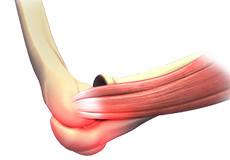
Anatomy of the Elbow
The elbow is a complex hinge joint formed by the articulation of three bones – the humerus, radius and ulna. The upper arm bone or humerus connects the shoulder to the elbow, forming the upper portion of the hinge joint. The lower arm consists of two bones, the radius and the ulna. These connect the elbow to the wrist and form the lower portion of the hinge joint. A joint capsule surrounds the elbow joint, which contains a lubricating fluid called synovial fluid. Ligaments are thickened areas in the capsule that connect one bone to another.
What is an Elbow Sprain?
An elbow sprain is an injury to the soft tissues of the elbow. It is caused due to stretching or tearing (partial or full) of the ligaments that support the elbow joint.
Causes of Elbow Sprains
The various causes of an elbow sprain are:
- Twisting of the arm during sport activities
- Traumatic injury to the elbow due to an accident or fall
- Overstretching of the elbow during exercise, which increases tension on the elbow
- Lack of warming up and stretching prior to performing exercises or sports activities
Symptoms of Elbow Sprains
The common symptoms of an elbow sprain include:
- Pain, swelling, tenderness and bruising around the elbow
- Restricted movement of the elbow
- Pain at the elbow joint while stretching
- Severe elbow sprains can lead to joint instability or dislocation
Diagnosis of Elbow Sprains
Your doctor will take a detailed medical history and perform a thorough physical examination of your elbow. An X-ray of the elbow may be necessary to rule out any fractures or other disease conditions. Occasionally, an MRI may be ordered.
Treatment options for Elbow Sprains
The treatment for an elbow sprain is as follows:
- Rest: Avoid using the affected elbow for a few weeks. Restrict all activities that cause overuse of the elbow.
- Ice: Apply ice packs wrapped in a towel over the sprained elbow for 15-20 minutes at a time to help alleviate pain and swelling.
- Compression: An elastic compressive bandage is used to wrap and support the elbow to reduce swelling. Take care not to wrap it too tightly, as it could constrict the blood vessels.
- Elevation: Keep your elbow elevated by placing pillows under your arm.
- Immobilization: A sling or splint may be applied to help protect the elbow joint.
- Physical therapy: Learn appropriate hand exercises that strengthen your forearm muscles. Various modalities of physical therapy such as massage, ultrasound, and muscle stimulation may also be performed to improve range of motion and muscle strength.
- Surgery: Generally, elbow sprains do not require surgery. It is indicated only in cases of severe damage or tearing of the ligament.
Related Topics
- Triceps Injuries
- Osteochondritis Dissecans of the Capitellum
- Elbow Trauma
- Elbow Arthritis
- Bicep Tendon Tear at the Elbow
- Elbow Dislocation
- Triceps Tendonitis
- Elbow (Olecranon) Bursitis
- Elbow Sprain
- Tennis Elbow
- Golfer's Elbow
- Little League Elbow
- Nursemaid's Elbow
- Elbow Pain
- Elbow Contracture
- Distal Humerus Fractures of the Elbow
- Radial Head Fractures of the Elbow
- Elbow Fractures
- Ulnar Nerve Neuropathy
- Loose Bodies in the Elbow
- Radial Tunnel Syndrome
- Lateral Ulnar Collateral Ligament Injuries (Elbow)
- Post-traumatic Stiffness (Elbow)
- Cubital Tunnel Syndrome (Ulnar Nerve Entrapment)





